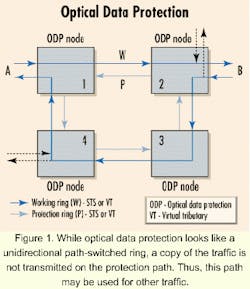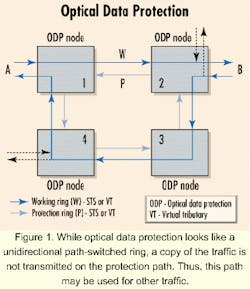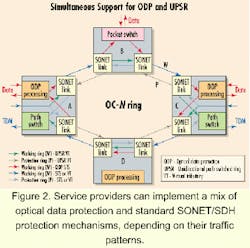Optical data protection improves multiservice network access
A new protection scheme supports and improves upon existing SONET/SDH protection mechanisms.
Jonathan A. Morgan
Appian Communications Inc.
Today, SONET/SDH is the predominant technology for transport in worldwide public carrier networks.
One of the key attributes of SONET/SDH is its ability to provide network survivability in point-to-point, ring and mesh architectures.
The survivability methods employed in SONET networks, including unidirectional path-switched ring (UPSR) and bidirectional line-switched ring (BLSR), were designed and optimized primarily for decades-old, time-division multiplexing (TDM)-based non-data services, where communication between nodes on a SONET ring is point-to-point over a path that cannot be shared by other nodes on the ring. As a result, every connection to a SONET ring must be provisioned with a dedicated path that consumes a full bandwidth path (e.g., T3 and OC-3), regardless of whether it's being used.
With the continuing explosion of the Internet, and with data traffic expected to constitute about 90% of all traffic by 2005, new data-optimized protection techniques are required that don't sacrifice the standard capabilities provided by SONET. One new survivability technique, called optical data protection (ODP), provides such optimization.
ODP is a survivability technique developed to provide the benefits of traditional SONET TDM protection mechanisms, while simultaneously offering much higher bandwidth efficiencies for data traffic. ODP allows a service provider to provision nodes in a ring similar to a SONET UPSR. Thus, while UPSR works well for data that has a single ingress path and single egress path, it does not work for a scenario where a single path (e.g., STS-1) has multiple ingress and multiple egress paths. That's where ODP comes in.Data traffic tends to be bursty in nature, which lends it to being statistically multiplexed among several customers, such that any given bandwidth pipe (e.g., STS-1 or a wavelength) can be oversubscribed. Statistical multiplexing is the principle behind today's packet data services such as frame relay and ATM-when one customer is not sending much or any traffic, the idle bandwidth on that pipe is available to other customers. Existing SONET protection schemes are extremely inefficient and waste vast amounts of bandwidth to carry data traffic. By contrast, ODP, because it is packet-based, specifies a protected path that can be shared among several ingress and egress points along the same SONET path in a ring. Multiple ingress and egress points and statistical multiplexing allow several customers to share the same single path through the SONET ring providing a high degree of bandwidth efficiency-and dramatically lowering overall network costs.
While other emerging optical access technologies offer mesh-based light-path and lambda protection at the optical layer, ODP is the first approach that is optimized for data as well as designed for ring protection at the optical layer. Fully interoperable with existing SONET nodes, ODP provides the same 50-msec protection capabilities as SONET. And in the event of a failure, ODP provides an alternate path around the failure to ensure traffic remains connected from source to destination. In addition, because it is protocol-independent, ODP allows ATM, frame relay, and IP to co-exist on the same ring. That's a major advantage over protocol-specific, non-SONET-compatible techniques such as dynamic packet transport (DPT) or ATM virtual-path (VP) rings.
Better bandwidth efficiency for data traffic is ODP's main advantage over existing TDM-based ring survivability mechanisms such as UPSR. For example, Figure 1 shows a four-node ring using ODP. One fiber on the ring is designated the working fiber, which is always used to add and drop data onto the payload. The other fiber ring is the protection fiber, which is used only during failures.Dedicating one fiber to working traffic and the second fiber traveling in the opposite direction to protecting traffic is the same mechanism used by UPSR. But unlike UPSR, the protection channel does not carry a duplicate copy of the signal. Therefore, ODP allows support for extra traffic, non-preemptive traffic, and preemptive traffic over the protection channel (similar to BLSR), thus doubling the traffic-carrying capacity of the fiber ring.
Another example further illustrates the advantage of ODP over traditional UPSR. Assume a four-node ring with nodes 1, 2, and 3 are located in a multitenant building and node 4 is a node at a central office interconnected to the carrier's backbone network. All traffic from nodes 1, 2, and 3 is destined for node 4.
For simplicity, assume that three customers at each node want 15 Mbits/sec of bandwidth each. With ODP, bandwidth is shared across the three nodes. That means the 15 Mbits/sec of traffic from each of the three nodes (totaling 45 Mbits/sec) can be carried over a single STS-1.
In addition to providing better bandwidth efficiency, ODP assists service providers to migrate from their TDM-based access-network infrastructures to more efficient packet technologies. One of ODP's key migration features is its ability to operate simultaneously with UPSR on the same physical SONET ring, making the ring fully compatible with existing SONET add/drop-multiplexing equipment. Because ODP is a path layer mechanism, an ODP node can be connected to any other standard SONET/SDH or DWDM network element. ODP paths are essentially tunneled through non-ODP nodes for transparent interworking with existing SONET rings.
The benefit of this approach is that both new data traffic and legacy TDM services can be supported simultaneously on the same ring. Standard UPSR can be used for tributaries that require TDM characteristics, such as T1 voice, while ODP is used for data tributaries that share a SONET path among multiple customer nodes on the ring (see Figure 2).
ODP can also be used on its own to create access rings that feed multinode customer traffic into existing SONET or other optical rings. Service providers could use such access ring architectures to provision optical-network service to entire buildings or campuses using just one SONET path to connect multiple customers to the service provider's larger metropolitan ring.
Unlike other ring-protection methods, ODP's switching mechanism is independent of the type of data being carried (e.g., frame relay, Internet Protocol, and ATM). Other survivability mechanisms, such as ATM VP rings, address specific technologies at the protocol layer. But in a multiservice environment, various types of packet streams will be carried over the same optical path.
ODP uses a technique similar to SONET "line switching" at the path level where nodes adjacent to the failed path perform the ring switching. Switching decisions are made based on path failure indications, with each path independent of the other paths.Thus, a failure detected on the working fiber entering a node will cause an upstream failure indication (UFI) to be sent on the working fiber. A failure detected on the protection fiber entering the node will cause a downstream failure indication (DFI) to be sent on the protection fiber. When the node that originated the DFI receives a UFI on its working fiber, it bridges the traffic onto the protection fiber. When the node that originated the UFI receives a DFI on its protection fiber, it performs a ring switch and begins receiving the data on the protection fiber.
Figure 3 illustrates what occurs in the case of a two-fiber failure in an ODP ring. In this example, a two-fiber failure occurs between nodes 1 and 4. Nodes 1 and 4 detect the failure on the working and protection fibers, respectively. Node 1 sends a UFI upstream on the working fiber and node 4 sends a DFI downstream on the protection fiber. Nodes 3 and 2, and all successive intermediate nodes, pass through the traffic and the ODP signaling protocol. Node 4, upon receipt of the UFI from node 1, loops back or "bridges" the working traffic to the protection channel. Upon receipt of the DFI from node 4, node 1 switches traffic from the protection fiber onto the working fiber. Once the failure is healed and the condition clears, the signaling mechanism reverts the ring back to its normal state.
Optical data protection is the first ring protection mechanism that allows sharing of SONET and other optical paths among multiple nodes on a ring. By enabling customer traffic to be statistically multiplexed over optical access paths, ODP delivers the benefits of traditional SONET TDM protection mechanisms, while offering much higher bandwidth efficiencies-and lower costs-for data service.
Network service providers can use ODP to provision optical access without deploying or consuming a full STS path for each customer. And because ODP's ring protection is independent of traffic type, it can protect multiple packet types simultaneously on the same path, supporting multiservice networks with a simpler integrated survivability mechanism.
For network migration and interoperability with existing TDM services, ODP can work with any SONET ring architecture such as UPSR or BLSR, while allowing both ODP and traditional SONET protection on the same ring simultaneously. ODP switches in less than 50 msec, with a path-switching mechanism that allows only individual affected paths to be switched.
Working transparently with existing SONET facilities, ODP allows fiber rings to better support the mix of customers and traffic types in today's multiservice networks.
Jonathan A. Morgan is director of product management at Appian Communications Inc. (Boxborough, MA).


